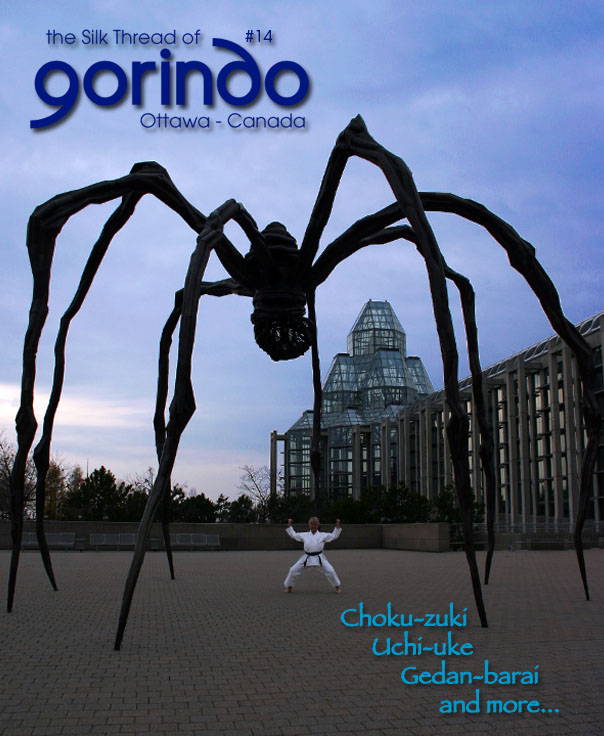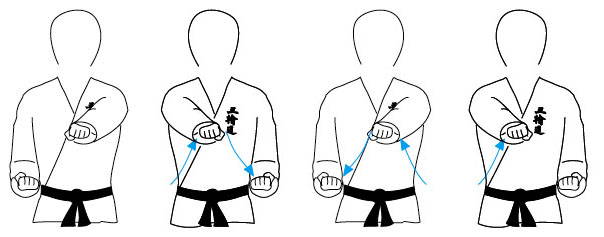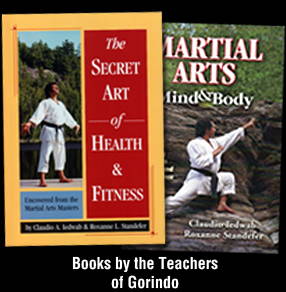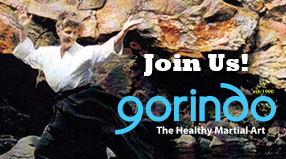
The Silk Thread of Gorindo - Ottawa - Canada
Issue 14
- Middle Block In-outside - Uchi-uke
- Downward Block - Gedan-barai
Photo cover Roxanne Standefer sensei with Louise Bourgeois's Maman, a sculpture of a giant spider outside the National Gallery of Canada's main entrance, Ottawa, Ontario, December 2011. Photo by Claudio Iedwab.
Straight Punch - Choku-zuki

Standing in the parallel stance, heiko dachi, (feet shoulder width apart pointing forward), pull one fist back to just above the belt beside your floating ribs, with the back of the hand facingdown to the floor.
 Meanwhile extend the other fist out in front of your solar plexus (to protect your body during this chambering stage), with the back of the fist facing the ceiling. To punch, begin by slowly switching the position of the fists, keeping the elbow close in beside the body, almost touching it. The idea is to draw a straight line in the air between the original fist position and the target, in this case the adversary’s solar plexus. Use the two first knuckles to contact the target, keeping the back of the hand up.
Meanwhile extend the other fist out in front of your solar plexus (to protect your body during this chambering stage), with the back of the fist facing the ceiling. To punch, begin by slowly switching the position of the fists, keeping the elbow close in beside the body, almost touching it. The idea is to draw a straight line in the air between the original fist position and the target, in this case the adversary’s solar plexus. Use the two first knuckles to contact the target, keeping the back of the hand up.
Note that the shoulders should be relaxed and in a straight line perpendicular to the target. Don’t allow your punching shoulder to be thrown forward. Maintain an isosceles triangle (equal on two sides) between your striking fist and your two shoulders. If the shoulder of the striking fist is too far forward in relation to the other shoulder the impact of the strike will be absorbed in the cervical and dorsal vertebras of the spinal column. The natural articulation of the neck and spine will be affected and possibly seriously damaged.
Note: there are other techniques that involve the shoulder in a forward position, but these will be introduced later in advanced stages of the training; hip, distance, stances, speed, and dynamic movement are developed.
Avoid hyper-extension of the elbow joint. Do not straighten it completely - some flex must be maintained. If you relax your forearm and elbow beside your body notice that the elbow joint has a natural angle bend. This is the same angle that you form during the choku-zuki.
In the punch position, with the back of the hand towards the ceiling, the wrist has to bend a little with the hand slightly lower than the wrist and turned so that the first two knuckles are higher than the others.
These points will help you prevent injuries in the wrist, elbow and shoulder.
Imagine that your arm is a pipe with a current of water inside. The maximum pressure is in the center of the pipe. Using this analogy the power of your choku-zuki is in the center of the arm and you have to localize and focus that energy flow into the two first knuckles. Work on the correct angle of the wrist to align the knuckles with the center of the arm. Maintain your body in a vertical position throughout.
When you execute the choku-zuki from the hip (basic punch) twist the fist and forearm before the impact: specifically, when your elbow starts to leave the side of the body. Simultaneously strike behind you with the other elbow, for action/reaction.
 Remember, at the moment of impact exhale your air and tense your body completely for good kime (maximun expression of your energy during a minimun time) expressed with a short exhalation of air ‘from the abdomen’. Keep your body relaxed (shoulders and hips especially) until this point.
Remember, at the moment of impact exhale your air and tense your body completely for good kime (maximun expression of your energy during a minimun time) expressed with a short exhalation of air ‘from the abdomen’. Keep your body relaxed (shoulders and hips especially) until this point.
You can improve your speed with the following tips:
• From the start position (one fist forward and the other beside the hip) move first the forward fist back to the hip and try to finish the motion of both fists at the same time.
• Think of striking with the other elbow behind you, rather than concentrating on the choku-zuki forward.
• Rotate the opposite hip very slightly forward in the direction of the punch during the inhaling and suddenly twist back in the opposite way during the execution of the choku-zuki, exhaling the air and generating a powerful torque that produces a reaction transmitted to the striking fist.
Common Corrections
• Allowing the lead shoulder to be thrown forward. In this case all the power of the impact will be directed to one shoulder producing injuries or transmitting force to the column in a transversal direction to the vertebrae. As well you can easily be pulled forward off balance.
• Not focusing the impact through the line of force between the two first knuckles, wrist and elbow. Not using the two first knuckles to make contact.
• Twisting the fist too late during the last part of the elbow extension.
• Opening your elbows out from the body during the action.
• Hyper-extending the elbow.
• Over-rotation of the hips.
• Inhaling when you execute the choku-zuki.
• Not closing the fist properly.
• Not pulling back with the opposite elbow.
by Claudio Iedwab & Roxanne Standefer
Originallly published in the Gorindo Student Manual by Claudio Iedwab & Roxanne Standefer
©2011 Illustrations by Claudio Iedwab
- Middle Block In-outside - Uchi-uke
- Downward Block - Gedan-barai
« Click the Subscribe link on the left




